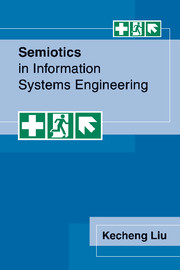Book contents
- Frontmatter
- Contents
- Preface
- 1 Introduction
- Part one Semiotic framework and methods
- 2 Understanding semiotics
- 3 A semiotic framework for information systems
- 4 A semiotic approach to information systems development
- 5 Knowledge representation and information analysis
- 6 Semantic Analysis
- 7 Pragmatics and communication
- 8 The social layer: modelling organisations as information systems
- Part two Applications
- Appendix A Semantic templates and surrogate specification
- Appendix B LEGOL applications in the CRIS case
- Bibliography
- Index
3 - A semiotic framework for information systems
Published online by Cambridge University Press: 19 September 2009
- Frontmatter
- Contents
- Preface
- 1 Introduction
- Part one Semiotic framework and methods
- 2 Understanding semiotics
- 3 A semiotic framework for information systems
- 4 A semiotic approach to information systems development
- 5 Knowledge representation and information analysis
- 6 Semantic Analysis
- 7 Pragmatics and communication
- 8 The social layer: modelling organisations as information systems
- Part two Applications
- Appendix A Semantic templates and surrogate specification
- Appendix B LEGOL applications in the CRIS case
- Bibliography
- Index
Summary
A semiotics of Stamper (1973), based on the work of Peirce (1931–58), Morris (1938, 1946) and on others, and on ‘information theory’ (Shannon & Weaver 1949), has evolved into a set of semiotic methods for information systems. A radical, subjectivist stance has been accepted as the basic philosophy for developing the set of methods and tools for information systems development. In this chapter, the discussion will focus on the examination of the subjectivist paradigm and the semiotic framework (Stamper et al. 1988).
Philosophical stance
A paradigm is a set of the most fundamental assumptions adopted by a professional community that allows its members to share similar perceptions and engage in commonly shared practices. Scientific achievements recognised in the particular community and research traditions educate its members to commit themselves to the same rules and standards for scientific practice (Kuhn 1962). Adoption of a certain paradigm will determine the way of exploring the world; it will determine the research theory and method. The usual considerations on scientific paradigms may be complemented by considering a set of presuppositions as paradigmatic, thus relating the discussion to philosophy.
Objectivist paradigm
A predominant philosophical position is the objectivist paradigm which assumes that there is a subject-independent world, some objective reality. Objectivism in its rigorous forms regards the universe as being made up of self-existent entities.
Information
- Type
- Chapter
- Information
- Semiotics in Information Systems Engineering , pp. 21 - 36Publisher: Cambridge University PressPrint publication year: 2000
Accessibility standard: Unknown
Why this information is here
This section outlines the accessibility features of this content - including support for screen readers, full keyboard navigation and high-contrast display options. This may not be relevant for you.Accessibility Information
- 1
- Cited by
